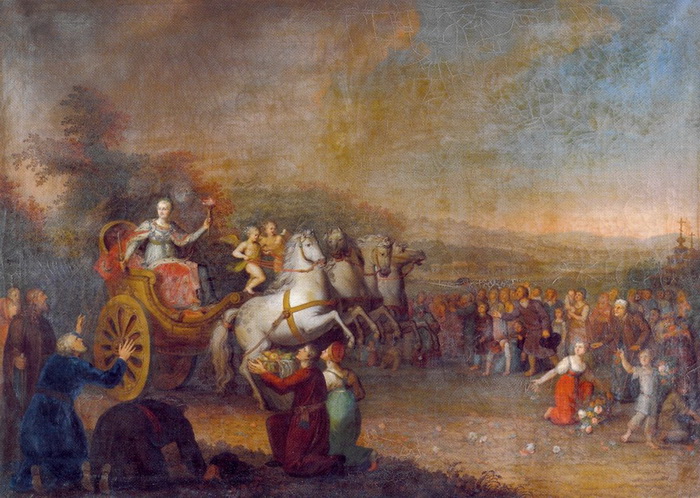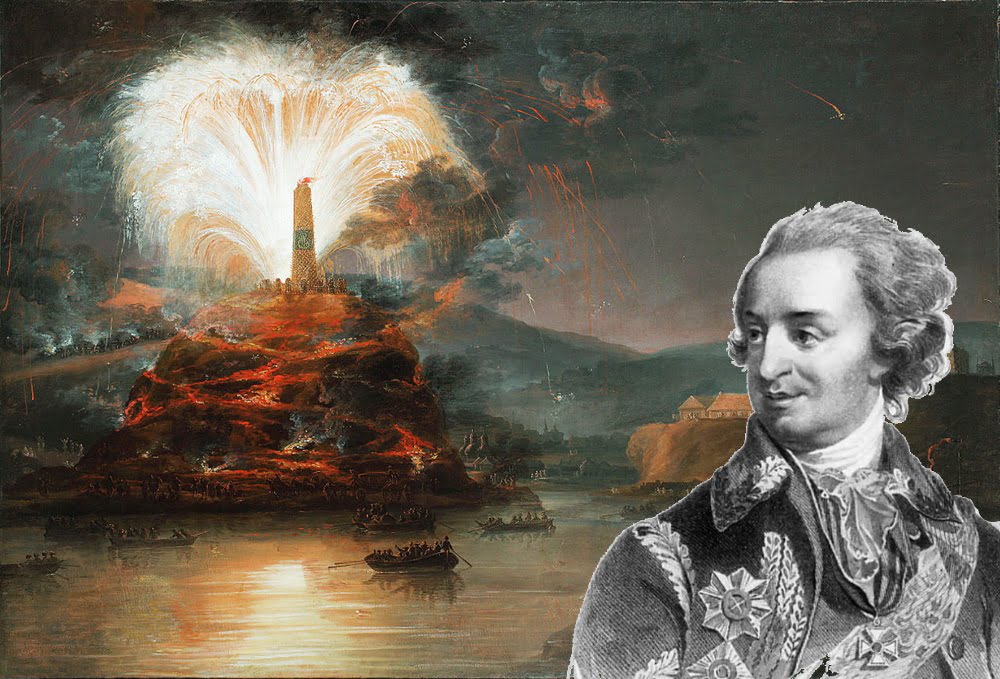According to legend, during Catherine II’s trip to the south of the Russian Empire, Grigory Potemkin ordered the construction of fake villages that were supposed to demonstrate prosperity in the region. We checked whether this was really the case.
The expression “Potemkin villages” has long become synonymous with ostentatious splendor and deception, and it is popular not only in Russia, but also in the West. The episode with which its appearance is associated occurred in 1787. Empress Catherine II periodically undertook trips around the province to monitor the state of affairs in the country. And this time her choice fell on a vast zone in the south, part of which became part of the empire as a result of the recent wars with the Turks. Fortunately, this territory was ruled by Prince Grigory Potemkin, Catherine’s closest associate, her secret husband and one of the most influential people in the state. The large-scale trip, which lasted for six months, included visits to more than three dozen cities right up to the southern coast of Crimea. The Empress and her retinue covered 5,657 versts (about 6,000 km).
It is clear that such a visit-review had to be carefully prepared. Already in 1784, through the efforts of Potemkin, large-scale construction began in the region. Not only roads were built, but also entire cities: Kherson, Simferopol, Sevastopol - as well as others, smaller ones. The Russian army was stationed in large numbers in a number of settlements along the future route. And here we come to the memoirs of Catherine’s contemporaries, which became the basis for the formation of a stereotype, at least in the West. In particular, the French traveler Alphonse de Forcia de Piles, who visited Russia only four years after the Empress’s Tauride voyage, wrote:
“... Numerous villages, the object of her admiration, were created for her passage and destroyed on the same day, and the unfortunate peasants, who came thirty and forty leagues to stand on the sides of the path and live in these houses for several days, were sent home. It was the invention of the genius Potemkin, who managed to convince his monarch with such a new kind of cunning that the country, revered as a desert, was flourishing.”
De Piles is echoed by his compatriot Thibault de Laveau in his “History of Peter III”:
“Art multiplied as we approached Potemkin’s provinces. Villages were visible at some distance from the shore; but the houses and bell towers were painted on boards as decoration. The villages closest to the road were built hastily and seemed inhabited; but those imaginary residents were brought by force fifteen or even eighty miles away. In the evening they were obliged to leave their imaginary houses and went all night to play a comedy in the next imaginary village, which the empress saw from afar.”
In one form or another, this information is included in many historical anecdotes.

However, modern scientists look at this legend with skepticism. Thus, a specialist in Russian history, Simon Sebag-Montefiore, in his book “Potemkin” writes: “Already in the 1770s, there were rumors that Potemkin’s activities in the south were pure fiction. When it became obvious that this was not so, his enemies began to whisper that the empress had been cruelly misled. The Saxon envoy Georg von Helbig, who was not involved in the trip, coined the expression "Potemkinische Dorf" - "Potemkin villages" - a formula that entered everyday language with the meaning of "false appearance".
<…>
The legend of the “Potemkin villages” is based on the story of a cruise on the Dnieper. Gelbig argued that the settlements that travelers saw were specially built facades - painted cardboard shields, each of which was shown to the empress five or six times. Thousands of peasants were allegedly torn from their homes, brought from the interior provinces, and, together with herds of cattle, they were transported along the river at night; a thousand villages were left abandoned, and many people died out from the ensuing famine.
The idea, which Gelbig gave its name, arose several years before Catherine’s journey. When Kirill Razumovsky visited Kherson in 1782, the city seemed to him a “pleasant surprise” - undoubtedly because he was assured that the whole project was nothing more than a mirage. All foreigners traveling to the south were warned in St. Petersburg that they were being misled: a year before Catherine left for the south, Lady Craven wrote that “Petersburg residents who were jealous of Potemkin” assured her that there was no water at all in Crimea. <…> For several years in a row, the Empress was told that Potemkin had invented all his achievements himself. Garnovsky informed the prince: she was warned that she would only see painted screens, and not real buildings.
There is nothing in Potemkin’s orders or eyewitness accounts that would confirm the story of the “Potemkin villages.” He began preparing for Catherine’s arrival back in 1784: then the ruler of the Tauride region, Vasily Kakhovsky, reported that new houses were being built and old houses were being renovated for the empress’s future visit. Potemkin himself used temporary residences, but most of those in which Catherine later stayed were permanent: the Kherson palace stood for more than a century. The Khan's Palace in Bakhchisarai was being repaired, the wooden parts were repainted, the garden was improved, and the fountains were repaired. The next year, Potemkin ordered the construction of new salt warehouses in Perekop, the planting of chestnut trees, and in Bakhchisarai “the large street where Her Imperial Majesty’s entrance is to be built up with good houses and shops.” Orders for the repair of existing buildings are the closest thing to the idea of a “cosmetic fiction”. Miranda, a completely unbiased witness, accompanied Potemkin on the trip preceding the reception of the Empress, and did not see anything resembling window dressing, but was only amazed at the scale of what was done.
As for the merry villagers and their herds on the banks of the Dnieper, no one could move such masses of people and animals at the speed of a flotilla, especially at night. Potemkin's failure to disguise his lagging kitchen fiasco at Kaidak, when he himself had to cook dinner for two monarchs, only confirms that he could not transport thousands of people and animals over vast distances to deceive his guests.
Of course, in the cities along the route of the Empress, the governors ordered to clean up the streets, paint the houses and hide everything unsightly. In Kharkov and Tula, two cities not included in the route planned by Potemkin, the governors actually hid some facts from Catherine and built false buildings: paradoxically, the very story of the “Potemkin villages” reports that in reality the creators of this legend were others. Perhaps Potemkin can be called the father of modern political shows, but he is by no means a flat deceiver.”
Sebag-Montefiore also quotes Prince de Ligne, a participant in that trip: “We heard the funniest stories about how there were cardboard villages along our route... that the ships and cannons were painted, and the cavalry had no horses. Even many Russians, who were jealous of us, the participants in the trip, will stubbornly repeat that we were deceived.”
This version is also indirectly confirmed by Count de Damas, who observed Potemkin’s activities in the 1780s, even before the empress’s historic visit: “I every hour come across new, fantastic Asian whims of Prince Potemkin. In half an hour he moves an entire province, destroys a city in order to rebuild it in another place, founds a new colony or factory.”
And historian Vladimir Shirokov writes about one of the episodes of the Empress’s visit to Sevastopol: “In the evening, after all the performances, the Empress was shown a “performance”: a fake town was set up on the North side, which was bombed, blown up and set on fire. And since there was a lot of flammable material there, the spectacle was very spectacular.”
News about such theatrical performances, transmitted by word of mouth, could only strengthen gossip about supposedly real decorative villages and towns. In an article dedicated to this legend, academician Alexander Panchenko notices: “Potemkin really decorated cities and villages, but he never hid the fact that these were decorations. Dozens of descriptions of travel around Novorossiya and Taurida have been preserved. In none of these descriptions, made hot on the heels of the events, is there a hint of “Potemkin villages,” although decoration is mentioned more than once.”
As for the testimonies of Alphonse de Forcy de Piles and Thibault de Laveau cited at the beginning of our study, the first Frenchman is known in his homeland as a hoaxer, and the second has never been to Russia and his conclusions are based on the texts of the same Georg von Gelbig.
Thus, modern historical science claims that rumors about “Potemkin villages” appeared even before Catherine II’s visit to these regions. They were the result of the active work of Grigory Potemkin, especially in relation to the construction of new and destruction of old infrastructure. Moreover, these rumors are believed to have prompted the empress to conduct an inspection. Of course, Catherine’s journey was accompanied by a certain amount of scenery, but they were a design element or, at best, covered up some flaws, but did not seriously depict entire settlements, and even portable ones. What was decoration was presented as decoration.
Mostly lies
Read on topic:
1. http://ec-dejavu.ru/p/Potemkin_village.html
2. https://coollib.com/b/335615/read#r755
3. http://dspace.nbuv.gov.ua/bitstream/handle/123456789/91017/65-Shirokov.pdf?sequence=1
4. https://arzamas.academy/materials/141
If you find a spelling or grammatical error, please let us know by highlighting the error text and clicking Ctrl+Enter.







